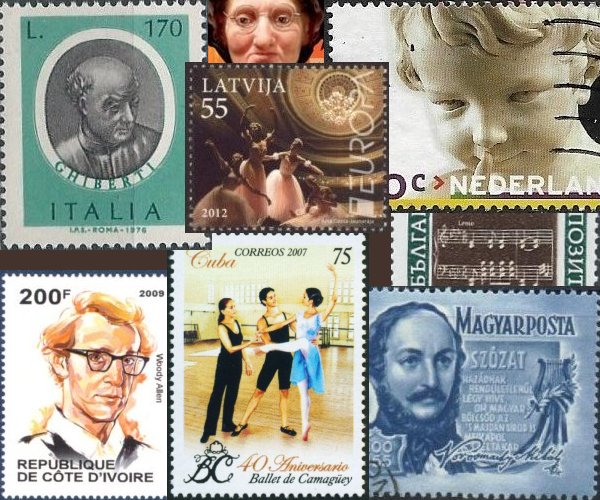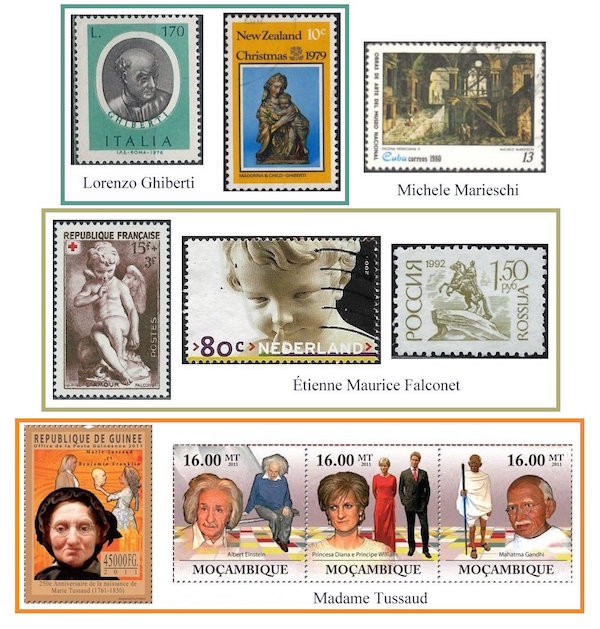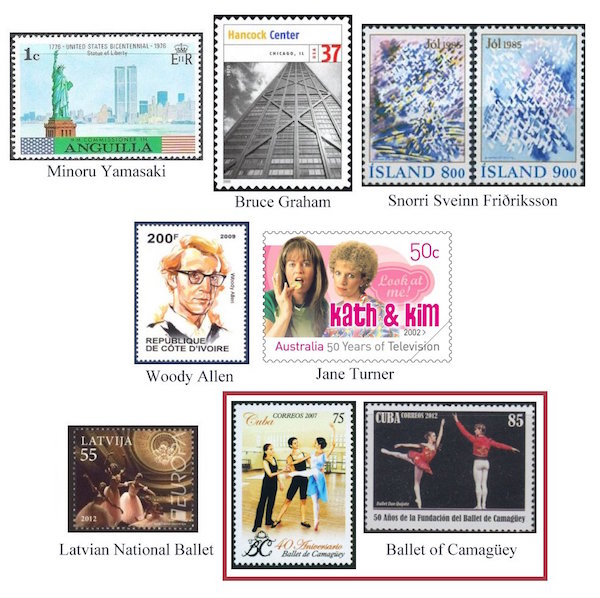The Arts on Stamps of the World — December 1
An Arts Fuse regular feature: the arts on stamps of the world.

By Doug Briscoe
Lorenzo Ghiberti, who died on this date in 1455, is the artist responsible for the bronze doors of the Florence Baptistery, so admired by Michelangelo that he called them the “Gates of Paradise”. Born outside Florence in 1378 as Lorenzo di Bartolo, Ghiberti learned goldsmithing from his father. In 1400 he fled the plague to Rimini and got work completing wall frescoes for the Malatesta family. The very next year, beating out Brunelleschi, he won the competition to design the doors, which were intended for the east side of the baptistery. For this object, Ghiberti, only 23 (Brunelleschi was only a year older), had to form a large workshop where, for the next 21 years, many artists would train, including Donatello, Uccello, and Antonio Pollaiuolo. On completion, the work so pleased everyone who saw it that Ghiberti was immediately sought for many other projects. Four years later, in 1425, he was asked to embark on a second set of doors, and these took twenty-eight years to complete. When they were finished, it was clear—to Michelangelo and others—that Ghiberti had outdone himself, and the older doors were moved to the north side of the baptistery so that the new and more splendid ones could take pride of place on the east side. Ghiberti was also a collector of classical artifacts, an historian, a promulgator of humanist ideas, and a writer who left unfinished a volume, part treatise and part autobiography (said to be the first by any artist), called the Commentaries.
Our next chronological subject was also an Italian artist, in this case a painter and engraver. Michele Marieschi (1 December 1710 – 18 January 1744) specialized in landscapes and vedute (views) of his native Venice. In his earlier efforts he also painted fantasy landscapes, and other works reflect architectural details that express Marieschi’s interest in stage design. The Cuban stamp shows a picture, identified here simply as Venetian Scene II, that hangs in Havana’s National Gallery, but I couldn’t find another image of it online. It’s quite similar to this other Marieschi piece, Courtyard with a Staircase.

Born six years to the day after Marieschi was the French sculptor Étienne Maurice Falconet (1716 – 24 January 1791). He was born poor and apprenticed to a carpenter, but in idle moments he fashioned clay figures that were at one point seen by Jean-Baptiste Lemoyne (1704-1778), who was impressed enough to take Falconet on as a pupil. His early small piece Milo of Croton, on the same subject as the famed statue bu Pierre Puget (q.v.), but with a very different approach, gained Falconet’s admission to the Académie des beaux-arts in 1754. (He would become the director of that institution 34 years later.) Thereafter he met with such success as to be appointed director of the sculpture workshop at Sèvres and to be patronized by Mme de Pompadour. It was she who commissioned Menacing Love (L’Amour menaçant, 1757), which we see in full on a French stamp, with a close-up of the head on one from the Netherlands. In 1766, Falconet was invited to St Petersburg by Catherine the Great, and there, in collaboration with his pupil and stepdaughter Marie-Anne Collot, he created a huge equestrian statue of Peter the Great called The Bronze Horseman. This is seen on a small definitive (I am tempted to say a diminutive definitive) from Russia (one of the earlier post-Soviet issues of 1992). Falconet also wrote extensively on his art, his Oeuvres littéraires filling six volumes, and Diderot asked him to supply the article on sculpture for his Encyclopédie. Sadly, much of Falconet’s religious work fell victim to the ravages of the French Revolution, which also had a harrowing effect on our next personage.
I refer to Anna Maria “Marie” Tussaud (1 December 1761 – 16 April 1850), the Madame Tussaud of wax museum fame. She never knew her father, who was killed fighting in the Seven Years’ War before Marie was born. At the age of six she was taken by her mother from her native Strasbourg to Bern, where they found lodgings with a doctor named Philippe Curtius (1741–1794). It was from Curtius that Marie learned the skill of wax modelling. Initially, Curtius undertook this pursuit for the purposes of anatomical illustration, but he became so good at it that he later turned to portraits and even opened a Paris firm with that express object. In 1765, the year the firm was established, he made a waxwork of Madame du Barry. This led to a series of exhibitions, and in 1777, Marie made her own wax figure, one of Voltaire. During the Revolution, wax heads of royalists made by Curtius were carried in mockery in the streets, and Marie found herself arrested as a royal sympathizer. She was on the brink of execution when a prominent member of the Committee of Public Safety intervened. Marie was then set to work creating death masks of the Revolution’s most illustrious victims, including the king and queen, Marat, and Robespierre, which were then paraded through the city for more good-natured fun. Curtius died in 1794, leaving his entire wax work collection to Marie. The next year she married a civil engineer by the name of François Tussaud. In 1802, she responded to an invitation to London to show her work. The impresario cheated her and, with the Napoleonic Wars raging, she and her small son were unable to return to France (she never saw her husband again), so she set about taking her pieces on the road as a traveling exhibition all through Britain. This life Tussaud led for the next 33 years. In 1835, Madame Tussaud’s opened on Baker Street in London. One of her pieces was a self-portrait created in 1842 and still on display (see the Guinean stamp), as are a number of her other originals. Madame Tussaud lived to be 88. I chose a few stamps from a Mozambique issue showing waxworks of Einstein, Princess Diana and Prince William, and Mahatma Gandhi. There are now 28 Tussaud’s museums all around the world, seven of them in the United States. The newest one, in Delhi, is scheduled to open today!
Hungarian poet and dramatist Mihály Vörösmarty (1 December 1800 – 19 November 1855) is an important figure in the literature of his nation. He was born into the nobility, but his father’s early death left the family in extreme poverty. Vörösmarty, through tutoring, earned enough to afford college. In the main, his poetry reflects the subjects of unrequited love and patriotism. The patriotic impulse produced the epic poem The Flight of Zalán (1824), a step forward into Romanticism. He wrote eight shorter epics and four plays within the next several years and, on acquiring a professorship at the newly established Hungarian Academy in 1830, wrote what is held by some to be the finest 19th-century Hungarian play, Csongor and Tünde, partly inspired by A Midsummer Night’s Dream. (Leó Weiner wrote some very appealing incidental music to Csongor and Tünde in 1913.) In 1836 Vörösmarty wrote what came to be regarded as a sort of second national anthem in his “Szózat” (“Appeal”, cited on the more recent stamp). Otherwise he tended in this period to concentrate more on drama until 1843, when a new amour and subsequent marriage inspired more love poetry. In the meantime in 1837 he founded two periodicals, one for belles lettres and the other for criticism. With fellow poets János Arany and Sándor Petőfi he contributed to a translation of the works of Shakespeare. When Vörösmarty died shortly before his 55th birthday, his children were cared for under a national subscription organized by the statesman Ferenc Deák, who acted as their guardian. The third and fifth of Liszt’s seven Historical Hungarian Portraits for piano (1884-86) are named for Vörösmarty and Deák respectively. (The sixth is for Petőfi.)

The French painter Marie Bracquemond (December 1, 1840 – January 17, 1916) is seen by some art lovers as the third great figure in the troika of woman Impressionists that also includes Berthe Morisot and Mary Cassatt. She was born Marie Quivoron in Brittany under less favorable circumstances than her compeers. But her talent was sufficient to gain her acceptance to the Paris Salon and through that to lessons with Ingres. Soon enough she was receiving commissions from the nobility. She married artist Félix Bracquemond (who happens to share a birthday with Cassatt) in 1869. While recognizing her talent he dissented from her approach to Impressionism, especially after her meeting with Gauguin, and was actually somewhat jealous of her work, which he neglected to show to guests. In addition to her paintings she also designed some impressive dinner plates and tiles. Two of the stamps from a Comoran sheet offer Self-Portrait (1870), The Artist’s Son and Sister in the Garden at Sèvres (1890), Woman with an Umbrella (1880), and Prawns (Crevettes). For more on Marie Bracquemond, visit this expansive web page.
Between the wars Croatian writer Slavko Kolar (1 December 1891 – 15 September 1963) penned a series of excellent stories and novels focusing on the lives of Croatians in villages and small towns, treating them with a sort of melancholy humor that established him as the finest of modern Croatian humorists. From 1946 he lived in Zagreb and added a few plays to his output of fiction.
Bulgarian composer Petko Staynov (December 1, 1896 – June 26, 1977) went blind at the age of 11. He attended the Institute for the Blind in Sofia and later taught there. He held leadership positions with a number of Bulgarian musical institutions, including the Institute for Music, which he directed for the last thirty years of his life. Staynov wrote orchestral music (two each of symphonies and symphonic poems, etc.), choral ballads, chamber music, and songs, but recordings are rare.
The Aragonese operatic tenor Miguel Fleta was, according to some accounts, born on December 1, 1897. (Grove Online and English-language Wikipedia say December 28, but all other sources I checked agreed on December 1.) He made his debut in 1919 in Trieste as Paolo in Zandonai’s Francesca da Rimini under the composer’s direction. In the early to mid-1920s he sang at both La Scala (1923-26) and the Met (1923-25). His most signal achievement, perhaps, was the creation of the role of Calaf in Puccini’s Turandot (1926) at the insistence of Toscanini. Fleta died of uremia at the age of 40 on May 29, 1938.
One of the most significant architects of the 20th century, Minoru Yamasaki (December 1, 1912 – February 6, 1986) was the designer of the original World Trade Center in New York City and the Conservatory of Music at Oberlin College (1963), among many other large-scale projects. He was born in Seattle and began studying architecture in 1929. He lived, studied, and worked in New York until 1945, when he was hired by a Detroit firm. Four years later Yamasaki established his own partnership there, which continued in operation until 2009. He returned to his hometown to design the Pacific Science Center for the 1962 Seattle World’s Fair. Yamasaki himself has not been honored with a stamp, but the World Trade Center can be seen on an Antiguan stamp issued to commemorate the American Bicentennial in 1976. Yamasaki’s son Taro is a Pulitzer Prize-winning photographer.

Another prominent American architect was Colombian-born Bruce Graham (December 1, 1925 – March 6, 2010), the child of a Canadian father and Peruvian mother whose first language was Spanish. He attended universities in Puerto Rico, Pennsylvania, and Ohio and began his career in Chicago. There he assisted Fazlur Khan in the design of the Sears Tower (since 2009 the Willis Tower). Ironically, that structure topped Yamasaki’s World Trade Center as the world’s tallest building just two years after the WTC’s completion in 1971 and held the record for 24 years. The stamp, however, shows Graham’s John Hancock Center for Chicago, itself a hundred stories in height, built in 1968 with Khan as structural engineer. His other buildings can be found all over the world, with numerous projects in London.
Icelandic artist Snorri Sveinn Friðriksson (born December 1, 1934) is represented on a pair of Christmas stamps from 1985. To tell the truth, I’m not certain whether the stamps made use of already existing paintings or the images were designed for the stamps.
A great American original, if you’ll pardon my decidedly unoriginal way of putting it, is Heywood Allen, born Allan Stewart Konigsberg 82 years ago today, and known to us all as Woody Allen. The stamp is one from a set of American film people issued by Côte d’Ivoire in 2009.
Australian actress and comedian Jane Turner (born 1 December 1960) had a hit with the comedy series Kath and Kim, for which she was creator, writer, producer, and star opposite her friend and professional partner Gina Riley. Both are seen together on the Aussie stamp, with Turner on the left.
Two ballet companies can trace their origins to the first of December. The Latvian National Ballet, associated with the Latvian National Opera, gave its first performance on this date in 1922, when they put on La fille mal gardée. A separate entity from the Cuban National Ballet, the Ballet of Camagüey was founded on 1 December 1967 by Vicentina de la Torre. Ballet was staunchly supported by Castro, and in consequence Cuba has issued many stamps on the subject. These two are among those specifically honoring the Ballet de Camagüey.
A graduate of the University of Massachusetts with a B.A. in English, Doug Briscoe worked in Boston classical music radio, at WCRB, WGBH, and WBUR, for about 25 years, beginning in 1977. He has the curious distinction of having succeeded Robert J. Lurtsema twice, first as host of WGBH’s weekday morning classical music program in 1993, then as host of the weekend program when Robert J.’s health failed in 2000. Doug also wrote liner notes for several of the late Gunther Schuller’s GM Recordings releases as well as program notes for the Boston Classical Orchestra. For the past few years he’s been posting a Facebook “blog” of classical music on stamps of the world, which has now been expanded to encompass all the arts for The Arts Fuse.
